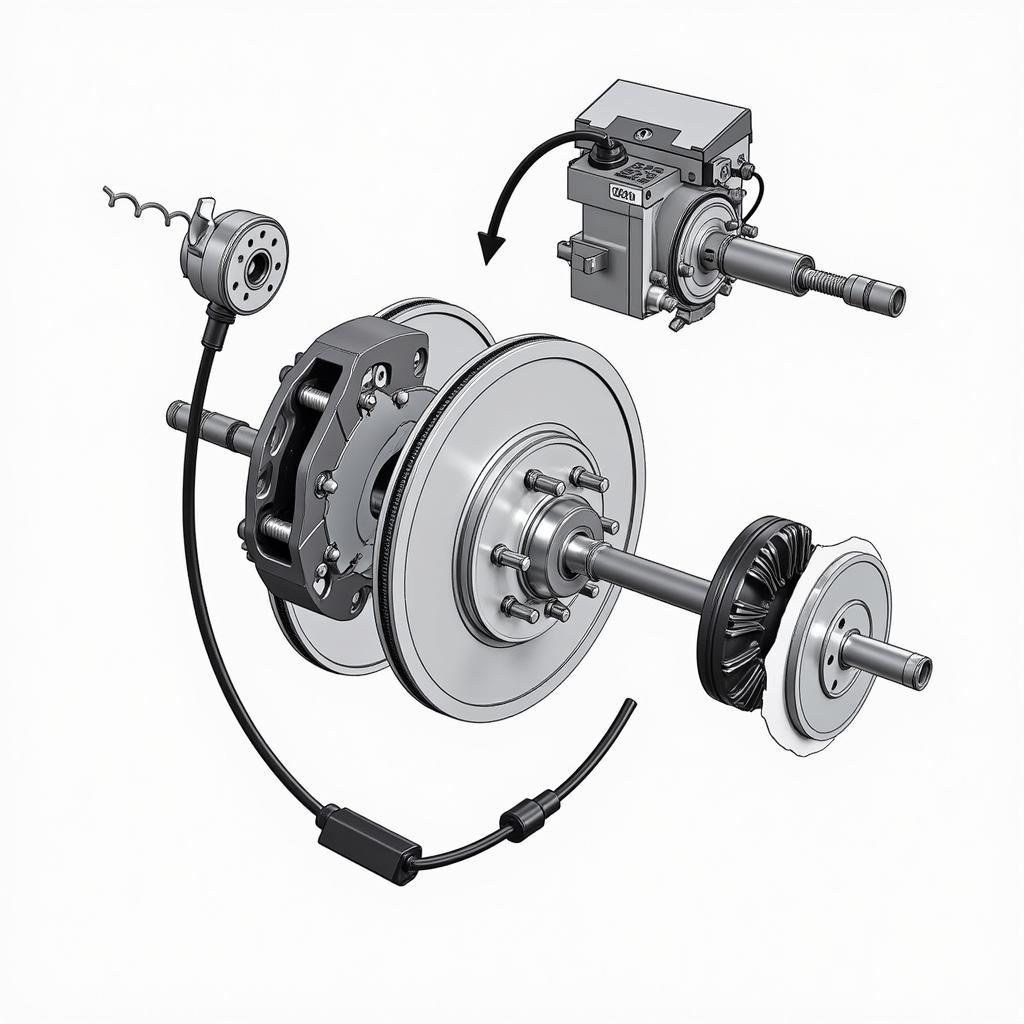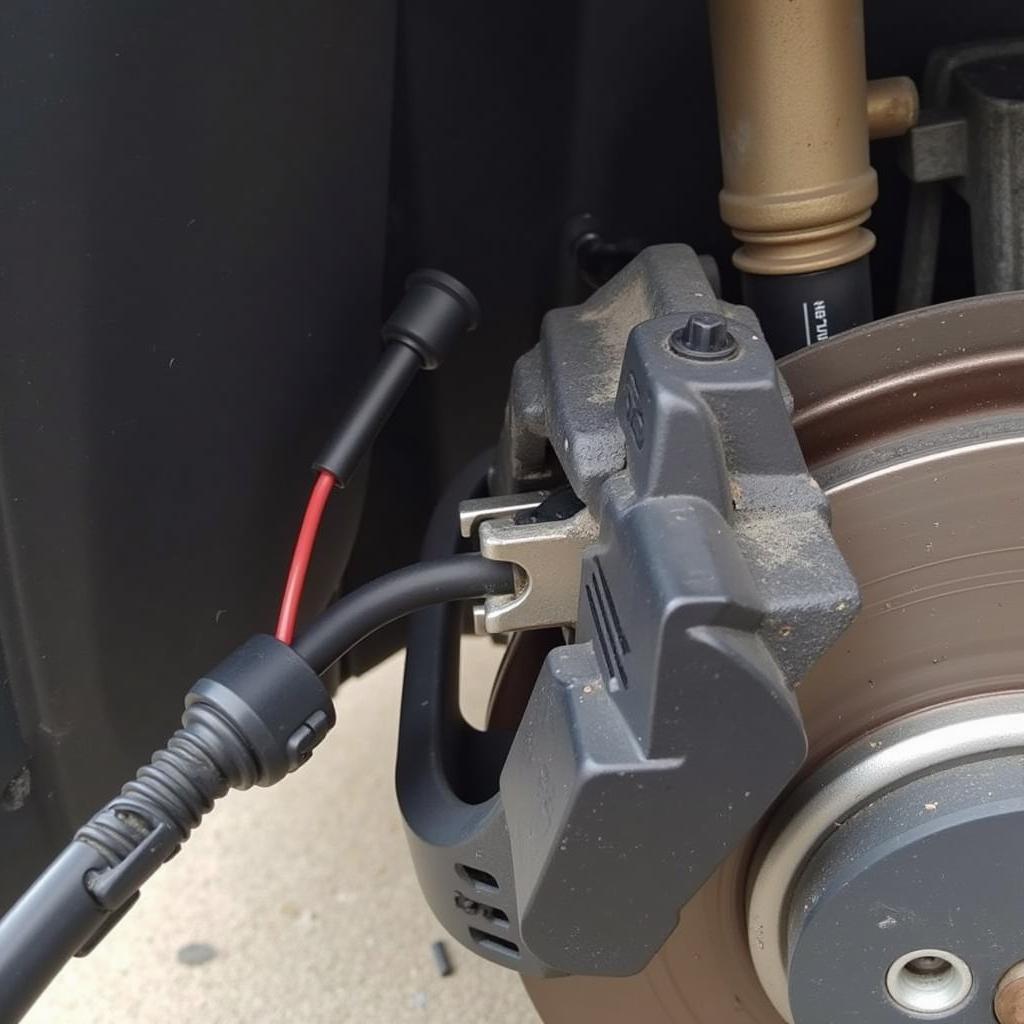The dreaded brake warning light on your BMW X5 dashboard can be a nerve-wracking experience. This amber or red light usually signifies an issue with your braking system, potentially jeopardizing your safety on the road. This article will guide you through the common reasons behind the X5 brake warning light illuminating and provide potential solutions to get you back on track safely.
Understanding Your X5’s Brake System
Before diving into the causes, it’s important to have a basic understanding of your BMW X5’s sophisticated braking system. It’s comprised of several key components working in harmony:
- Hydraulic System: This system utilizes brake fluid to transmit force from the brake pedal to the brake calipers, effectively slowing down or stopping your vehicle.
- Electronic Parking Brake: Unlike traditional handbrakes, the X5 utilizes an electronic parking brake (EPB) controlled by a button. This system is responsible for immobilizing your vehicle when parked.
- Anti-lock Braking System (ABS): The ABS is a crucial safety feature that prevents wheel lockup during hard braking, maintaining steering control and stability.
- Dynamic Stability Control (DSC): This advanced system works in conjunction with the ABS to monitor various driving conditions and selectively apply brakes to individual wheels, enhancing traction and preventing skids.
 BMW X5 Brake System Components
BMW X5 Brake System Components
Common Causes of the X5 Brake Warning Light
Now, let’s explore the common culprits behind the X5 brake warning light and how to address them:
1. Worn Brake Pads
Expert Insight: “Brake pads are your first line of defense when it comes to stopping your vehicle,” says Mark Stevenson, a seasoned automotive engineer with over 15 years of experience in vehicle diagnostics. “Their wear and tear is inevitable, and neglecting timely replacement can lead to more serious and costly brake system damage.”
The most frequent cause is worn-out brake pads. These pads are designed to wear down over time due to friction generated during braking. When they reach a certain thickness, a sensor embedded within the pad triggers the warning light on your dashboard.
Solution: If your brake pads are worn, the most straightforward solution is a brake pad replacement. It’s recommended to replace all four brake pads simultaneously for even braking performance.
2. Low Brake Fluid Level
Expert Insight: “Brake fluid is the lifeblood of your braking system,” says Maria Sanchez, a certified mechanic specializing in European vehicles. “A drop in fluid level often indicates a leak somewhere in the system, which requires immediate attention.”
The hydraulic system relies on adequate brake fluid to function correctly. A low fluid level, often caused by leaks in the brake lines, hoses, or calipers, can hinder the system’s ability to generate the necessary pressure for braking.
Solution: If you suspect a brake fluid leak, it’s crucial to inspect the brake lines, hoses, and connections for any signs of leakage. If you identify a leak, it’s crucial to address it promptly and replenish the brake fluid.
3. Faulty Brake Sensor
While less common, a malfunctioning brake pad wear sensor can also trigger the warning light. These sensors are prone to damage from road debris or general wear and tear.
Solution: If you’ve ruled out worn brake pads and a brake fluid leak, the next step is to inspect the brake pad wear sensors. If a sensor is found to be faulty, it should be replaced.
 Inspecting a Brake Pad Wear Sensor
Inspecting a Brake Pad Wear Sensor
4. ABS Module Malfunction
The ABS module is a critical electronic component responsible for regulating the anti-lock braking system. In some cases, a malfunctioning ABS module can trigger the brake warning light.
Solution: Diagnosing an ABS module issue typically requires specialized diagnostic equipment. If you suspect a problem with the ABS module, it’s best to consult a qualified mechanic or BMW specialist.
5. Issues with the Electronic Parking Brake (EPB)
A malfunctioning electronic parking brake can also trigger the brake warning light. This could be due to a faulty EPB switch, a problem with the EPB actuator, or an issue with the EPB control module.
Solution: Similar to the ABS module, diagnosing EPB issues often requires specialized diagnostic tools. Consult a qualified mechanic or BMW specialist to address any suspected EPB malfunctions.
What to Do When the X5 Brake Warning Light Comes On
If your X5’s brake warning light illuminates while driving, it’s crucial to:
- Stay Calm: Don’t panic! A illuminated warning light doesn’t always mean imminent brake failure.
- Assess the Situation: Are you experiencing any braking issues like a spongy brake pedal, unusual noises, or reduced braking performance?
- Pull Over Safely: If possible, safely guide your vehicle off the road and away from traffic.
- Inspect: Carefully check your brake fluid level. If it’s significantly low, do not attempt to drive further.
- Seek Professional Help: Contact a qualified mechanic or BMW specialist to diagnose and address the issue.
Resetting the Brake Warning Light
2002 bmw x5 brake warning light reset
Once you’ve addressed the underlying cause of the brake warning light, it’s essential to reset it. This typically involves using a specialized diagnostic tool to clear the fault codes stored in the vehicle’s computer.
Important Note: While there are DIY methods for resetting the brake warning light, it’s generally recommended to have it done by a qualified technician to ensure the issue is resolved correctly.
Preventative Maintenance is Key
reset bmw x5 brake warning light
Preventing brake issues is always preferable to dealing with them after they arise. Here are some proactive measures to help you maintain a healthy braking system in your X5:
- Regular Brake Inspections: Have your brakes inspected at least once a year, or more frequently if you drive in demanding conditions.
- Timely Brake Pad Replacement: Don’t wait for the warning light to illuminate! Adhere to the manufacturer’s recommended brake pad replacement intervals.
- Brake Fluid Flush: Flush your brake fluid every 2 years or as recommended by BMW to ensure optimal hydraulic system performance.
Conclusion
A illuminated brake warning light on your BMW X5 should never be ignored. By understanding the common causes and taking prompt action, you can ensure your safety on the road and potentially prevent more costly repairs down the line. Remember, when it comes to your vehicle’s braking system, erring on the side of caution and seeking professional assistance is always the wisest course of action.
